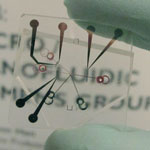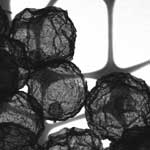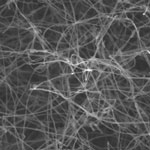Showing Spotlights 97 - 104 of 152 in category All (newest first):
 'Smart' windows, or smart glass, refers to glass technology that includes electrochromic devices, suspended particle devices, micro-blinds and liquid crystal devices. Their major feature is that they can control the amount of light passing through the glass and increase energy efficiency of the room by reducing costs for heating or air-conditioning. In the case of self-powered smart windows the glass even generates the energy needed to electrically switch its transparency. A new type of smart window proposed by researchers in The Netherlands makes use of a luminescent dye-doped liquid-crystal solution sandwiched in between electrically conductive plates as an energy-generating window.
'Smart' windows, or smart glass, refers to glass technology that includes electrochromic devices, suspended particle devices, micro-blinds and liquid crystal devices. Their major feature is that they can control the amount of light passing through the glass and increase energy efficiency of the room by reducing costs for heating or air-conditioning. In the case of self-powered smart windows the glass even generates the energy needed to electrically switch its transparency. A new type of smart window proposed by researchers in The Netherlands makes use of a luminescent dye-doped liquid-crystal solution sandwiched in between electrically conductive plates as an energy-generating window.
May 12th, 2010
 Bioethanol, unlike petroleum, is a form of renewable energy that can be produced from common agricultural feedstocks such as sugar cane or corn. Ethanol is already widely used in siome countries, mainly as biofuel additive for gasoline. The tremendous hype about bioethanol in the past few years has now been followed by a debate about how useful bioethanol actually can replace gasoline. Concerns about its production and use relate to the large amount of arable land required for crops, as well as the energy and pollution balance of the whole cycle of ethanol production. Recent developments with cellulosic ethanol production and commercialization may allay some of these concerns. It offers the promise that any plant material, from grass to wood, and not just edible crops, could be used in the production of ethanol fuels. Consequently, cellulosic ethanol could allow ethanol fuels to play a much bigger role in the future than previously thought. With regard to cellulosic production and commercialization, bioethanol production from woody biomass by enzymatic hydrolysis of cellulosic components and fermentation has attracted much attention.
Bioethanol, unlike petroleum, is a form of renewable energy that can be produced from common agricultural feedstocks such as sugar cane or corn. Ethanol is already widely used in siome countries, mainly as biofuel additive for gasoline. The tremendous hype about bioethanol in the past few years has now been followed by a debate about how useful bioethanol actually can replace gasoline. Concerns about its production and use relate to the large amount of arable land required for crops, as well as the energy and pollution balance of the whole cycle of ethanol production. Recent developments with cellulosic ethanol production and commercialization may allay some of these concerns. It offers the promise that any plant material, from grass to wood, and not just edible crops, could be used in the production of ethanol fuels. Consequently, cellulosic ethanol could allow ethanol fuels to play a much bigger role in the future than previously thought. With regard to cellulosic production and commercialization, bioethanol production from woody biomass by enzymatic hydrolysis of cellulosic components and fermentation has attracted much attention.
Mar 25th, 2010
 Freshwater could become the oil of the 21st century - scarce, expensive and fought over. While over 70 per cent of the Earth's surface is covered by water, most of it is unusable for human consumption. Technological advances have made desalination and demineralization feasible - albeit expensive - solutions for increasing the world's supply of freshwater. However, nanotechnology- based water purification devices have the potential to transform the field of desalination. Researchers have now demonstrated a new, efficient and fouling-free desalination process based on the ion concentration polarization (ICP) phenomenon - a fundamental electrochemical transport phenomenon that occurs when an ion current is passed through ion-selective membranes - for direct desalination of sea water.
Freshwater could become the oil of the 21st century - scarce, expensive and fought over. While over 70 per cent of the Earth's surface is covered by water, most of it is unusable for human consumption. Technological advances have made desalination and demineralization feasible - albeit expensive - solutions for increasing the world's supply of freshwater. However, nanotechnology- based water purification devices have the potential to transform the field of desalination. Researchers have now demonstrated a new, efficient and fouling-free desalination process based on the ion concentration polarization (ICP) phenomenon - a fundamental electrochemical transport phenomenon that occurs when an ion current is passed through ion-selective membranes - for direct desalination of sea water.
Mar 22nd, 2010
 Among various nanomaterial candidates for water treatment, metal oxides have been widely used as removal agents for various heavy metal ions and their removal capacity was found to be relatively reliable. The removal mechanism for heavy metal ions is thought to be the formation of a strong bond between metal ions and metal oxide surfaces. This strong complexation is advantageous for complete removal of heavy metal ions but it presents a drawback if one wants to design a reusable agent by reviving the reaction site for heavy metal ions. Precisely because the removal mechanism is based on the strong complex formation between metal ions and oxide surfaces, recycling of these removal agents has proved to be difficult. Offering a potential solution, researchers have demonstrated a recyclable removal agent for heavy metal ions by fabricating a core-in-shell structure based on a core of carbon nanotubes and an iron oxide microcapsule structure.
Among various nanomaterial candidates for water treatment, metal oxides have been widely used as removal agents for various heavy metal ions and their removal capacity was found to be relatively reliable. The removal mechanism for heavy metal ions is thought to be the formation of a strong bond between metal ions and metal oxide surfaces. This strong complexation is advantageous for complete removal of heavy metal ions but it presents a drawback if one wants to design a reusable agent by reviving the reaction site for heavy metal ions. Precisely because the removal mechanism is based on the strong complex formation between metal ions and oxide surfaces, recycling of these removal agents has proved to be difficult. Offering a potential solution, researchers have demonstrated a recyclable removal agent for heavy metal ions by fabricating a core-in-shell structure based on a core of carbon nanotubes and an iron oxide microcapsule structure.
Mar 3rd, 2010
 Currently, potential and actual applications of nanotechnology in environmental technologies are receiving considerable attention worldwide. Relevant applications include environmental remediation (air, water and soil), monitoring, and resource saving (energy and materials). These technologies are not only intended for markets in wealthy countries, including in Europe, the USA and Japan, but may also be particularly useful for protecting consumers and the environment in emerging economies and developing countries. Furthermore, research groups and companies in emerging economies and developing countries are increasingly active in R+D and manufacturing environmental nanotechnologies, as part of a national knowledge economy. As an example, the ICPC-NanoNet project supports international research cooperation in environmental nanotechnology between the European Union and International Cooperation Partner Countries to the EU. This article focuses on the case of nanotechnology for water purification.
Currently, potential and actual applications of nanotechnology in environmental technologies are receiving considerable attention worldwide. Relevant applications include environmental remediation (air, water and soil), monitoring, and resource saving (energy and materials). These technologies are not only intended for markets in wealthy countries, including in Europe, the USA and Japan, but may also be particularly useful for protecting consumers and the environment in emerging economies and developing countries. Furthermore, research groups and companies in emerging economies and developing countries are increasingly active in R+D and manufacturing environmental nanotechnologies, as part of a national knowledge economy. As an example, the ICPC-NanoNet project supports international research cooperation in environmental nanotechnology between the European Union and International Cooperation Partner Countries to the EU. This article focuses on the case of nanotechnology for water purification.
Feb 22nd, 2010
 Solar-powered splitting of water promises an attractive, clean energy source and numerous research projects around the world are working on making this process sufficiently efficient - reducing the systems' cost and extending their lifetimes - to be able to compete with dirty carbon fuels on an industrial scale. Natural photosynthesis uses chlorophyll to absorbe visible light and many solar hydrogen cells are imitating this process by using light-sensitive organic dye molecules as light absorbers and then transfer the absorbed energy to a catalyst that reduces protons to hydrogen. Researchers in the UK have now shown that an inexpensive and environmentally benign inorganic light harvesting nanocrystal array can be combined with a low-cost electrocatalyst that contains abundant elements to fabricate an inexpensive and stable system for photoelectrochemical hydrogen production.
Solar-powered splitting of water promises an attractive, clean energy source and numerous research projects around the world are working on making this process sufficiently efficient - reducing the systems' cost and extending their lifetimes - to be able to compete with dirty carbon fuels on an industrial scale. Natural photosynthesis uses chlorophyll to absorbe visible light and many solar hydrogen cells are imitating this process by using light-sensitive organic dye molecules as light absorbers and then transfer the absorbed energy to a catalyst that reduces protons to hydrogen. Researchers in the UK have now shown that an inexpensive and environmentally benign inorganic light harvesting nanocrystal array can be combined with a low-cost electrocatalyst that contains abundant elements to fabricate an inexpensive and stable system for photoelectrochemical hydrogen production.
Feb 16th, 2010
 Carbon nanotubes are 'strange' nanostructures in a sense that they have both high mechanical strength and extreme flexibility. Deforming a carbon nanotube into any shape would not easily break the structure, and it recovers to original morphology in perfect manner. Researchers in China are exploiting this phenomenon by making CNT sponges consisting of a large amount of interconnected nanotubes, thus showing a combination of useful properties such as high porosity, super elasticity, robustness, and little weight. The nanotube sponges not only show exciting properties as a porous material but they also are very promising to be used practically in a short time. The production method is simple and scalable, the cost is low, and the sponges can find immediate use in many fields related to water purification.
Carbon nanotubes are 'strange' nanostructures in a sense that they have both high mechanical strength and extreme flexibility. Deforming a carbon nanotube into any shape would not easily break the structure, and it recovers to original morphology in perfect manner. Researchers in China are exploiting this phenomenon by making CNT sponges consisting of a large amount of interconnected nanotubes, thus showing a combination of useful properties such as high porosity, super elasticity, robustness, and little weight. The nanotube sponges not only show exciting properties as a porous material but they also are very promising to be used practically in a short time. The production method is simple and scalable, the cost is low, and the sponges can find immediate use in many fields related to water purification.
Feb 8th, 2010
 The batteries that power our everyday devices, from laptop computers, to mobile phones, watches, toys and flashlights, are a major source of pollution. The average household in the Western world uses about 20 batteries a year, resulting in hundreds of thousands of tons of discarded batteries that end up in landfills. When the battery casing corrodes, toxic heavy metals like mercury and cadmium can leak out and pollute soil and ground water. Researchers have been working on non-metal batteries but so far the performance of the used materials has not been good enough for commercial applications. One way to improve the performance of nonmetal-based energy storage devices is to use composite electrode materials of conductive polymers, deposited as thin layers on a suitable large surface area substrate. Researchers have now developed a novel polypyrrole-cellulose composite electrode material that is mechanically robust, lightweight, and flexible.
The batteries that power our everyday devices, from laptop computers, to mobile phones, watches, toys and flashlights, are a major source of pollution. The average household in the Western world uses about 20 batteries a year, resulting in hundreds of thousands of tons of discarded batteries that end up in landfills. When the battery casing corrodes, toxic heavy metals like mercury and cadmium can leak out and pollute soil and ground water. Researchers have been working on non-metal batteries but so far the performance of the used materials has not been good enough for commercial applications. One way to improve the performance of nonmetal-based energy storage devices is to use composite electrode materials of conductive polymers, deposited as thin layers on a suitable large surface area substrate. Researchers have now developed a novel polypyrrole-cellulose composite electrode material that is mechanically robust, lightweight, and flexible.
Sep 16th, 2009
 'Smart' windows, or smart glass, refers to glass technology that includes electrochromic devices, suspended particle devices, micro-blinds and liquid crystal devices. Their major feature is that they can control the amount of light passing through the glass and increase energy efficiency of the room by reducing costs for heating or air-conditioning. In the case of self-powered smart windows the glass even generates the energy needed to electrically switch its transparency. A new type of smart window proposed by researchers in The Netherlands makes use of a luminescent dye-doped liquid-crystal solution sandwiched in between electrically conductive plates as an energy-generating window.
'Smart' windows, or smart glass, refers to glass technology that includes electrochromic devices, suspended particle devices, micro-blinds and liquid crystal devices. Their major feature is that they can control the amount of light passing through the glass and increase energy efficiency of the room by reducing costs for heating or air-conditioning. In the case of self-powered smart windows the glass even generates the energy needed to electrically switch its transparency. A new type of smart window proposed by researchers in The Netherlands makes use of a luminescent dye-doped liquid-crystal solution sandwiched in between electrically conductive plates as an energy-generating window.
 Subscribe to our Nanotechnology Spotlight feed
Subscribe to our Nanotechnology Spotlight feed





